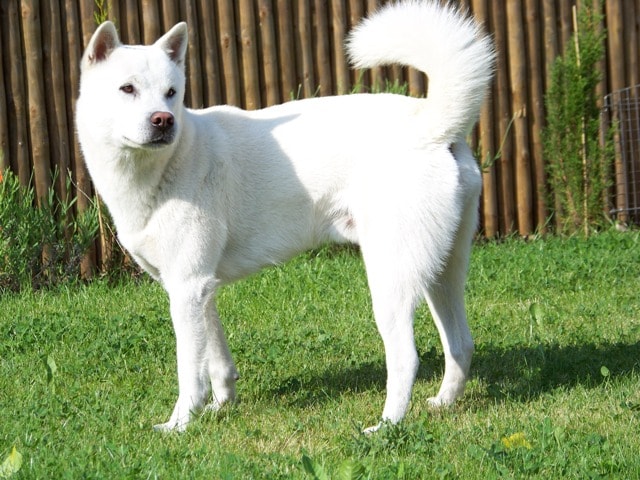Type the name of the breed you're looking for below
[wpdreams_ajaxsearchlite] Don't see the breed your're looking for? Click here and let us know!
Breed Characteristics
1 paw - breed exhibits the least amount of this characteristic
5 paws - breed exhibits most amount of this characteristic
Kishu Ken
| Other Names | Kishu, Kishu Inu |
| Country of Origin | Japan |
| Weight | 30 - 60 lbs. (13 - 27 kg) |
| Height (at withers) | 17 - 22 in. (43 - 56 cm) |
| Coat | The coarse double coat is short and straight with a thick, soft undercoat. |
| Colour | Coat colour mostly comes in white, but occasionally brindle, sesame or red do occur. |
| Litter Size | 3 - 6 puppies |
| Life Span | 12 - 14 years |
| Origin & History | A study in the 1930s carried out by a Japanese breeder, Haruo Isogai, classified all native Japanese dog breeds into three categories: large-, medium-, and small-sized. The Kishu Ken belongs the medium-sized dog group. Other medium-sized dogs are the Kai Ken, the Hokkaido Ken, and the Shikoku Ken. They are all very similar with overlapping colors and only minor differences in size and morphology. Kishu Ken are a primitive dog that was selectively bred for the hunting of wild boar and deer in the mountainous Wakayama prefecture. The breed was not standardized until 1934 and was composed of the dogs collected from that area. When the breed first started, approximately 70% of individuals were said to be non-white. The popularity of a primarily white line of Kishu Ken spread the gene responsible for white through the genepool and turned the Kishu Ken into the mostly-white breed it is today. The Kishu is a Foundation Stock breed with the American Kennel Club. The American Kishu Registry is the official Kishu registry in the United States and is recognized as such by AKC. Other registries include Japan Kennel Club (JKC) and Nihonken Hozonkai (NIPPO), both in Japan. The Nihonken Hozonkai is considered the main registry of the breed in its parent country and is responsible for the original breed standard. The Kishu has been recognized as a natural monument of Japan since 1934. Since this breed is so rare in North America and Europe, you may only get a chance to see it in its native homeland, Japan. |
| Personality | The Kishu Ken is loyal and loving with its family. It is a friendly, quiet and calm, but tough and agile breed. Intelligent, clean and easily housebroken. Can be aloof with strangers; socialize well. Not a barker. Does well with other dogs. An excellent pack hunter, the Kishu stalks prey rather than barks. It has a high prey drive and should be socialized with cats at a young age and should not be trusted with other small non-canine pets such as hamsters and guinea pigs. The Kishu has been known to climb trees to catch prey. This breed needs an owner who is calm, but firm, confident and consistent, displaying a natural authority over the dog. If the Kishu senses the humans around it are weaker minded than itself, it will become headstrong and willful as it will assume the position of the leader. Proper human to canine communication is essential. A Kishu Ken that is well socialized and that sees itself as below humans in the pack order will be good with children. Children should be taught not to tease the dog. |
Care Requirements
| Health | Health problems with the Kishu Ken are occasional Hypothyroidism (low thyroid), which is not uncommon among the Japanese breeds, and affects perhaps one in ten dogs. It is not life-threatening and treatment is a thyroid pill daily for the optimum health of the dog, as with humans. Food and environmental allergies are not uncommon in the Kishu Ken. The other known issue is Entropion, a genetic defect affecting the eye in which the eyelid turns inward and the lashes scratch the eyeball. This is connected in part to the triangular shape of the eye in the Kishu Ken. This requires surgery to prevent the loss of vision in the eye and continual pain to the dog. |
| Grooming | Brush weekly with a firm bristle brush, and bathe only when necessary. Trim nails and check ears regularly for dirt, wax buildup or infection. |
| Exercise | The Kishu Ken has a somewhat high energy level. It will do best with some type of job to do. Your dog needs to be taken on a daily, long walk or jog. While out on the walk the dog must be made to heel beside or behind the person holding the lead, as in a dog's mind the leader leads the way, and that leader needs to be the human. |
| Other Considerations | Does not do well in a kennel environment, they need to be part of the family. Should have a fenced-in yard. The works of manga artist Yoshihiro Takahashi feature many Kishu, characterizing them as skilled fighters. Akame of Ginga: Nagareboshi Gin Kyōshirō of Ginga Legend Weed. Also Sakura, the main character's mother, was a Kishu. This makes Weed, the main character, a Kishu/Akita mix—his father Gin was an Akita Inu. Gamu, Kusakage, Shiba, Tsuchigumo, Oboro, and Honō, the Ganin warriors of Kacchū no Senshi Gamu. |



